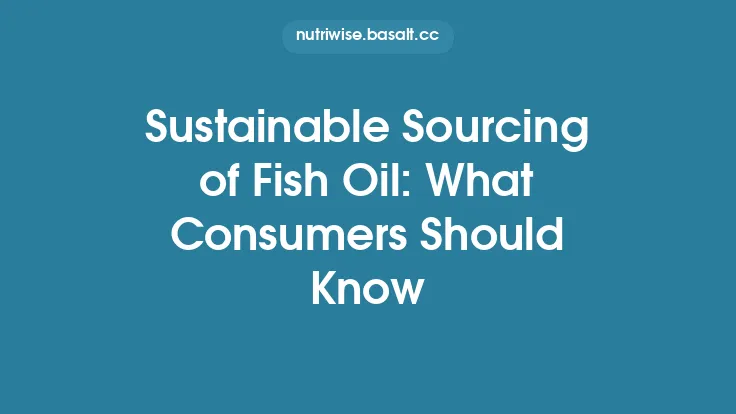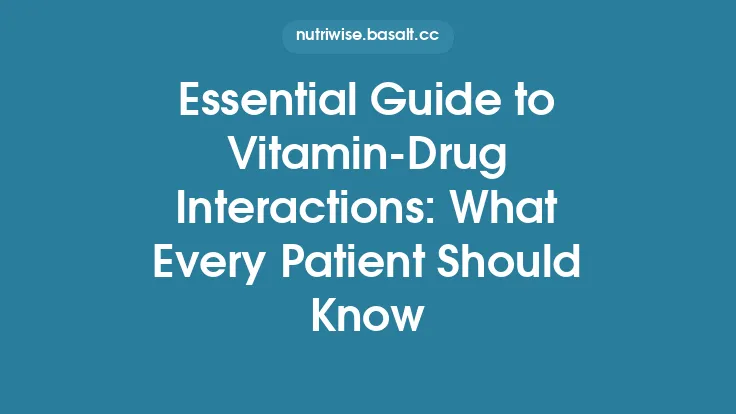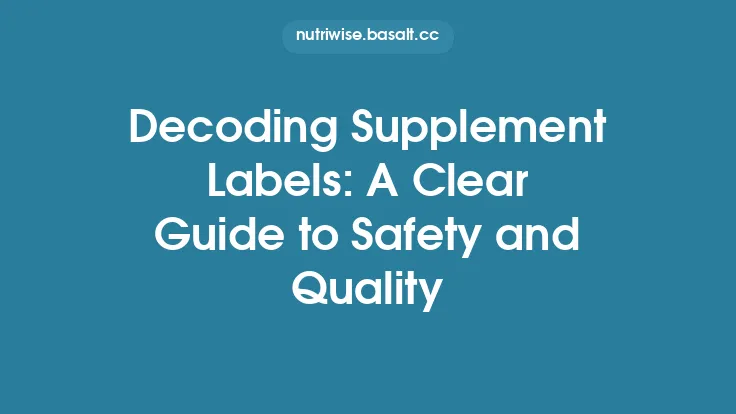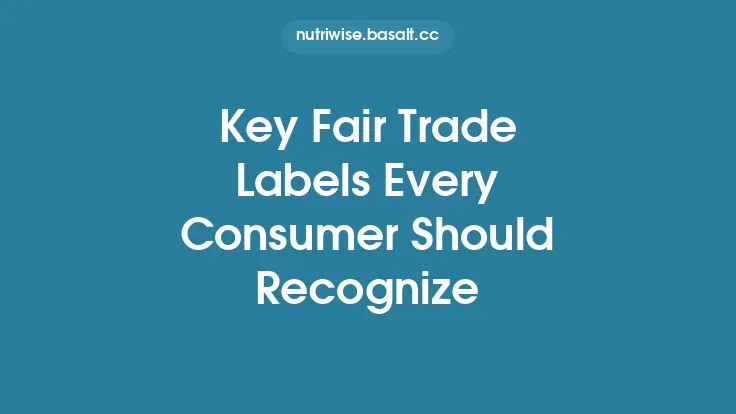The world of dietary supplements can feel like a maze of promises, scientific jargon, and marketing hype. While manufacturers are free to promote the benefits of their products, the U.S. Food and Drug Administration (FDA) still plays a crucial role in safeguarding public health. Understanding how the FDA regulates supplements—what it can and cannot do, what “approved” really means, and where you can find reliable information—empowers you to make smarter choices without getting lost in the fine print.
Overview of FDA Authority Over Dietary Supplements
The FDA’s jurisdiction over dietary supplements stems from the Federal Food, Drug, and Cosmetic Act (FD&C Act). Unlike prescription drugs, supplements are not subject to pre‑market approval for safety or efficacy. Instead, the agency relies on a combination of post‑market surveillance, labeling rules, and enforcement actions to protect consumers. This framework reflects a balance: allowing market innovation while providing a safety net against products that pose a risk.
Key points of FDA authority include:
- Prohibiting adulterated or misbranded products—any supplement that contains harmful substances, is contaminated, or makes false claims can be seized or recalled.
- Regulating labeling—the agency enforces specific language for ingredient lists, nutrition facts, and claim types.
- Monitoring adverse events—through mandatory reporting by manufacturers and voluntary reporting by consumers, the FDA can identify emerging safety concerns.
- Overseeing imports—most supplements sold in the United States are manufactured abroad; the FDA can detain or refuse entry to products that fail to meet U.S. standards.
The Dietary Supplement Health and Education Act (DSHEA) – Foundations
Enacted in 1994, the Dietary Supplement Health and Education Act (DSHEA) is the cornerstone of modern supplement regulation. DSHEA:
- Defines a dietary supplement as a product taken by mouth that contains a “dietary ingredient” such as a vitamin, mineral, herb, amino acid, or other botanical substance.
- Shifts the burden of proof—manufacturers must demonstrate that a product is safe, but they are not required to prove efficacy before marketing.
- Establishes claim categories—the law distinguishes between structure/function claims, health claims, and nutrient content claims, each with its own regulatory pathway.
Because DSHEA treats supplements more like foods than drugs, the FDA’s oversight is largely reactive rather than proactive. However, the act also grants the agency the power to issue warning letters, seize products, and pursue civil or criminal actions when violations occur.
How the FDA Defines “Dietary Supplement” and “Ingredient”
A clear definition helps both regulators and consumers know what falls under FDA oversight:
- Dietary Supplement: A product intended to supplement the diet, taken in tablet, capsule, powder, or liquid form, and containing one or more dietary ingredients.
- Dietary Ingredient: Includes vitamins, minerals, herbs or other botanicals, amino acids, and substances such as enzymes, organ tissues, or metabolites.
Importantly, the FDA does not regulate the manufacturing process (that falls under Good Manufacturing Practices, which we will not cover here) but does require that any ingredient be lawful—meaning it is either already marketed in the U.S. before October 15, 1994, or has undergone a New Dietary Ingredient (NDI) notification.
Pre‑Market Requirements: New Dietary Ingredient Notifications
If a supplement contains an ingredient that was not marketed in the United States before October 15, 1994, the manufacturer must submit an NDI notification to the FDA at least 75 days before the product’s first sale. The notification must include:
- Identity of the ingredient (chemical name, source, and manufacturing process).
- Safety data—including toxicology studies, human exposure information, and any known adverse effects.
- Intended use—how the ingredient will be used in the supplement.
The FDA reviews the submission to determine whether the ingredient is reasonably expected to be safe under the conditions of use. If the agency finds the data insufficient, it can issue a “no objection” letter (allowing marketing) or request additional information. Failure to submit an NDI when required can lead to enforcement actions, including product seizure.
Structure/Function Claims vs. Health Claims – What Consumers Should Understand
One of the most common sources of confusion is the distinction between structure/function claims and health claims:
| Claim Type | Definition | FDA Review Requirement |
|---|---|---|
| Structure/Function | Describes how a nutrient or ingredient supports a normal structure or function of the body (e.g., “Calcium helps maintain normal bones”). | No pre‑approval needed, but the claim must be truthful, not misleading, and accompanied by the disclaimer: “*This statement has not been evaluated by the Food and Drug Administration. This product is not intended to diagnose, treat, cure, or prevent any disease.*” |
| Health Claim | Links a nutrient or ingredient directly to a reduced risk of a disease or health condition (e.g., “Adequate calcium intake may reduce the risk of osteoporosis”). | Must be authorized by the FDA (or, in some cases, the National Academy of Sciences) after a rigorous scientific review. Only a limited set of health claims are currently permitted. |
| Nutrient Content Claim | States the level of a nutrient (e.g., “high in vitamin C”). | Must meet specific quantitative criteria set by the FDA. |
For consumers, the presence of a structure/function claim does not imply that the product has been proven to treat or prevent disease. It simply indicates that the manufacturer believes the ingredient supports a normal bodily function, and the claim must be accompanied by the standard disclaimer.
The Role of the FDA’s Center for Food Safety and Applied Nutrition (CFSAN)
Within the FDA, the Center for Food Safety and Applied Nutrition (CFSAN) is the primary hub for dietary supplement oversight. CFSAN’s responsibilities include:
- Developing and updating labeling regulations for supplements.
- Evaluating NDI notifications and determining safety.
- Coordinating post‑market surveillance through the Office of Dietary Supplement Programs (ODSP).
- Publishing guidance documents that clarify how manufacturers should comply with the law.
CFSAN also maintains several public databases that are valuable tools for consumers, such as the Recall Database, the Bad Ad Database, and the Dietary Supplement Ingredient Database.
Post‑Market Surveillance: Adverse Event Reporting and the MedWatch System
Because the FDA does not approve supplements before they reach the market, post‑market monitoring is essential. The agency relies on two main mechanisms:
- Manufacturer Reporting – Under the Dietary Supplement and Nonprescription Drug Consumer Protection Act (DSNCP), manufacturers must submit a Serious Adverse Event (SAE) report to the FDA within 15 days of receiving the information. The report includes details about the product, the adverse event, and any relevant medical information.
- Consumer Reporting – The MedWatch program allows anyone (health professionals, consumers, or manufacturers) to voluntarily report adverse events online, by phone, or via a downloadable form. These reports are entered into the FDA’s Safety Reporting Portal, where they are analyzed for patterns that may indicate a safety problem.
When a trend of serious adverse events emerges, the FDA can issue public health alerts, recall notices, or warning letters to the responsible company.
Enforcement Tools: Warning Letters, Recalls, and Import Alerts
The FDA’s enforcement toolbox includes several actions that directly affect product availability:
- Warning Letters – Issued when a company is found to be in violation of labeling, safety, or other regulatory requirements. The letter outlines the specific violations and demands corrective action within a set timeframe.
- Recalls – Voluntary or mandated removal of a product from the market. Recalls are classified into three categories:
- Class I – Situations where use of the product may cause serious health consequences or death.
- Class II – Products that may cause temporary or medically reversible adverse health effects.
- Class III – Products unlikely to cause adverse health effects but that violate labeling or other regulations.
- Import Alerts – When the FDA identifies a foreign manufacturer or product that fails to meet U.S. standards, it can place the source on an import alert. Products from that source are detained at the border until the company resolves the issue.
Consumers can track these actions through the FDA’s Recall and Enforcement Reports page, which provides searchable databases and real‑time updates.
Understanding “Approved” vs. “Allowed” Claims – Why “Approved” Is Rare
A common misconception is that a supplement bearing a claim has been “approved” by the FDA. In reality:
- Structure/function claims are allowed as long as they meet the disclaimer requirement and are not false or misleading. They are not FDA‑approved.
- Health claims must be authorized after a scientific review. Only a handful of health claims have received this authorization, and they are clearly labeled as “*authorized health claim*.”
- Nutrient content claims must meet specific quantitative thresholds set by the FDA; they are allowed but not “approved” in the drug sense.
When a product uses language that suggests FDA endorsement (e.g., “FDA‑approved”), it may be violating the misbranding provisions of the FD&C Act, which can trigger enforcement.
The Impact of the Food Safety Modernization Act (FSMA) on Supplements
Although FSMA primarily targets food safety, several provisions indirectly affect dietary supplements:
- Preventive Controls – Manufacturers must develop a written food safety plan that identifies potential hazards and outlines preventive measures. While the specifics are more relevant to food processors, supplement manufacturers that handle raw botanical materials often adopt similar practices.
- Supply‑Chain Transparency – FSMA requires detailed records of ingredient sources, which can help the FDA trace contaminated or adulterated products back to their origin.
- Import Safety – The Foreign Supplier Verification Program (FSVP) obligates U.S. importers to verify that foreign suppliers meet U.S. safety standards, adding another layer of oversight for imported supplements.
These FSMA elements reinforce the FDA’s ability to act quickly when a safety issue is identified, even though the act does not create a separate pre‑market approval process for supplements.
How to Verify a Supplement’s Compliance
Consumers can take a few practical steps to confirm that a supplement aligns with FDA regulations:
- Check the FDA’s Recall Database – Search by product name, brand, or UPC to see if the item has been recalled.
- Review the “Bad Ad” Database – This resource lists marketing claims that the FDA has deemed false or misleading.
- Look for the Required Disclaimer – Structure/function claims must be accompanied by the FDA disclaimer. Its absence is a red flag.
- Confirm the Ingredient’s Legal Status – Use the Dietary Supplement Ingredient Database to see whether an ingredient is recognized as a lawful dietary ingredient or if it requires an NDI.
- Verify the Manufacturer’s Contact Information – Legitimate companies provide a physical address and a phone number; the FDA can contact them if needed.
- Search the FDA’s “Food and Drug” Registration Listings – While not all supplement manufacturers are required to register, many voluntarily list their facilities, which can be cross‑checked.
Consumer Resources: FDA’s Online Tools and Guidance
The FDA offers a suite of free, publicly accessible tools that simplify the research process:
- FDA’s Dietary Supplement Consumer Information Page – A hub for FAQs, safety tips, and links to reporting adverse events.
- MedWatch Online Reporting System – Allows you to submit an adverse event report directly to the agency.
- Recall and Enforcement Reports – A searchable portal for recent recalls, warning letters, and import alerts.
- Bad Ad Database – Shows examples of prohibited marketing language and provides context for why certain claims are disallowed.
- Food and Drug Administration’s “Ask FDA” Service – Enables you to submit specific questions about a product or claim and receive a response from FDA staff.
These resources are updated regularly and can help you stay informed without having to sift through dense regulatory documents.
Practical Tips for Navigating FDA Information When Shopping
- Start with the Label – Verify that the product lists all ingredients in descending order of weight, includes the required disclaimer for any structure/function claim, and provides a clear “Supplement Facts” panel.
- Cross‑Reference the Ingredient – If you encounter an unfamiliar botanical or compound, search the FDA’s ingredient database to confirm its legal status.
- Check Recent Recall Lists – Before purchasing, especially from online marketplaces, run a quick search for the brand and product name in the FDA’s recall database.
- Beware of “FDA‑Approved” Language – Unless a product carries an authorized health claim, any suggestion of FDA approval is likely misleading.
- Report Concerns Promptly – If you experience an unexpected side effect, use MedWatch to submit a report. Your input contributes to the collective safety monitoring system.
- Use Trusted Retail Channels – Established retailers are more likely to have robust compliance checks and to remove products that trigger FDA actions.
By integrating these steps into your buying routine, you can enjoy the benefits of dietary supplements while minimizing exposure to potentially unsafe or misbranded products.
Bottom Line
Navigating the FDA’s regulatory landscape doesn’t require a law degree, but it does call for a clear understanding of what the agency can and cannot do. Supplements are allowed to be marketed without pre‑approval, yet they must adhere to strict labeling rules, safety reporting requirements, and post‑market enforcement mechanisms. By familiarizing yourself with DSHEA, the distinction between claim types, the NDI notification process, and the FDA’s consumer‑focused tools, you gain the confidence to evaluate products critically and protect your health.
Remember: “Approved” is a term reserved for drugs, not supplements. When a supplement’s claim is accompanied by the proper disclaimer and the product is free from FDA warnings or recalls, you have a solid foundation for a safe purchase. Stay curious, stay informed, and let the FDA’s publicly available resources guide your supplement journey.





